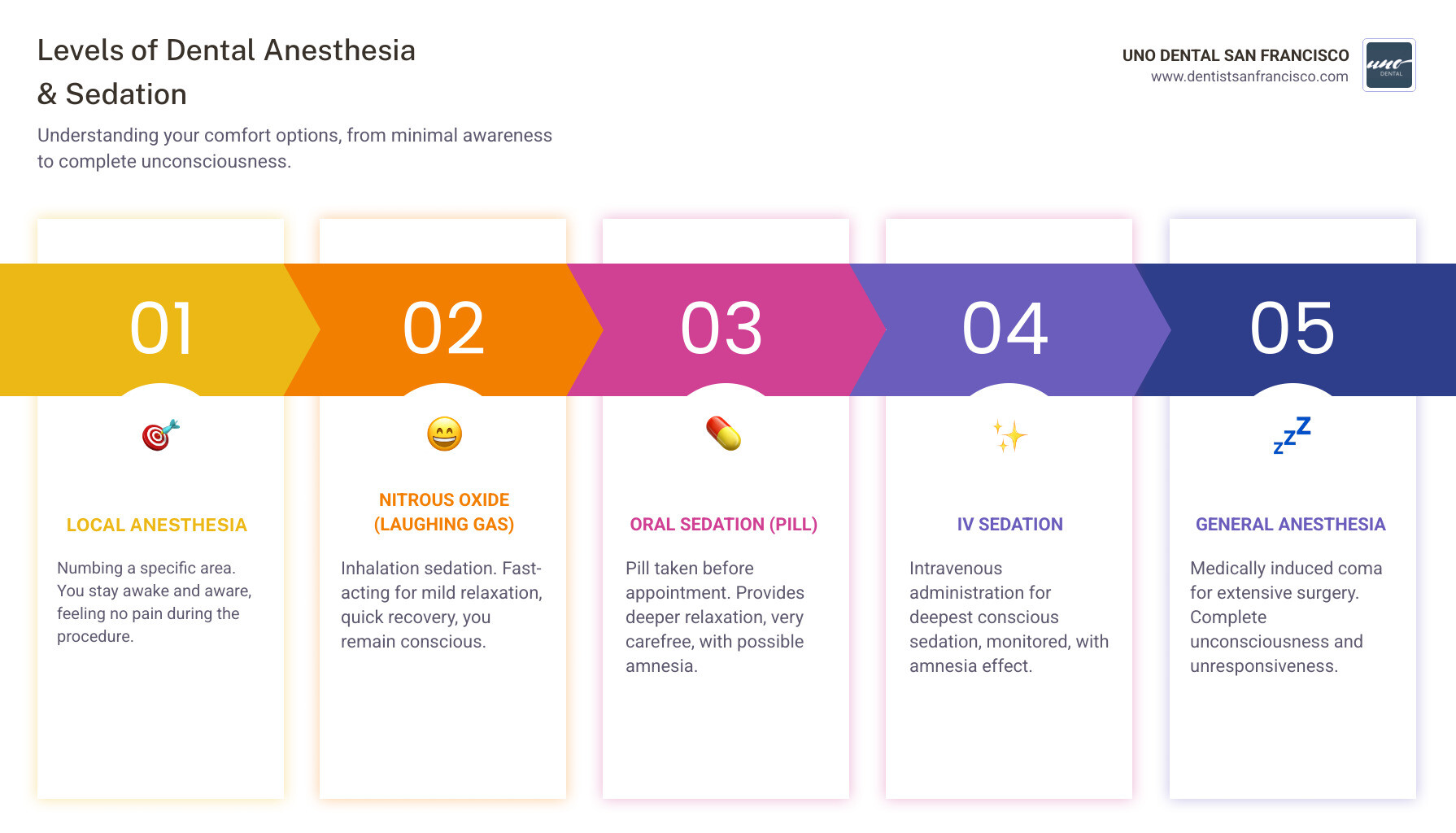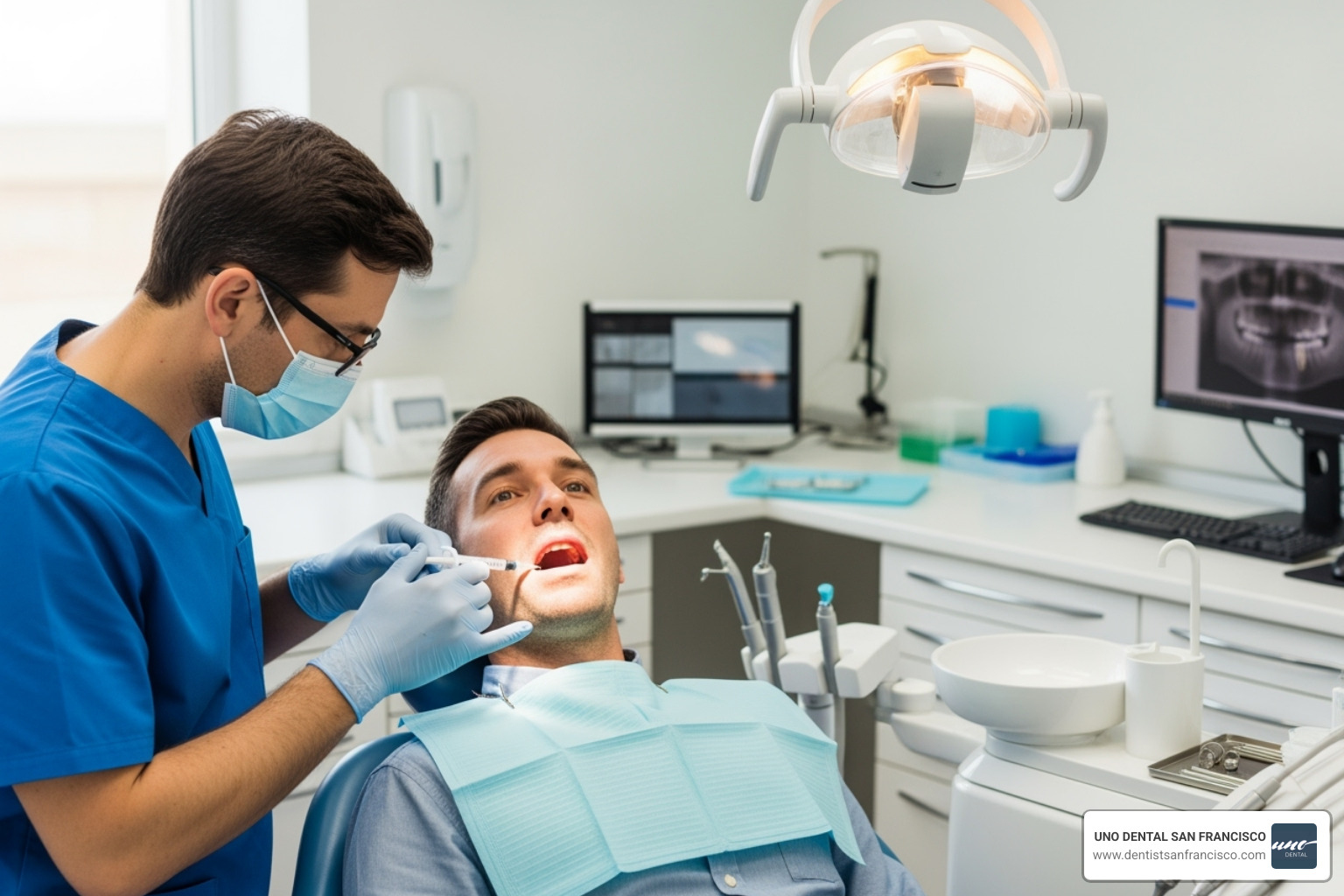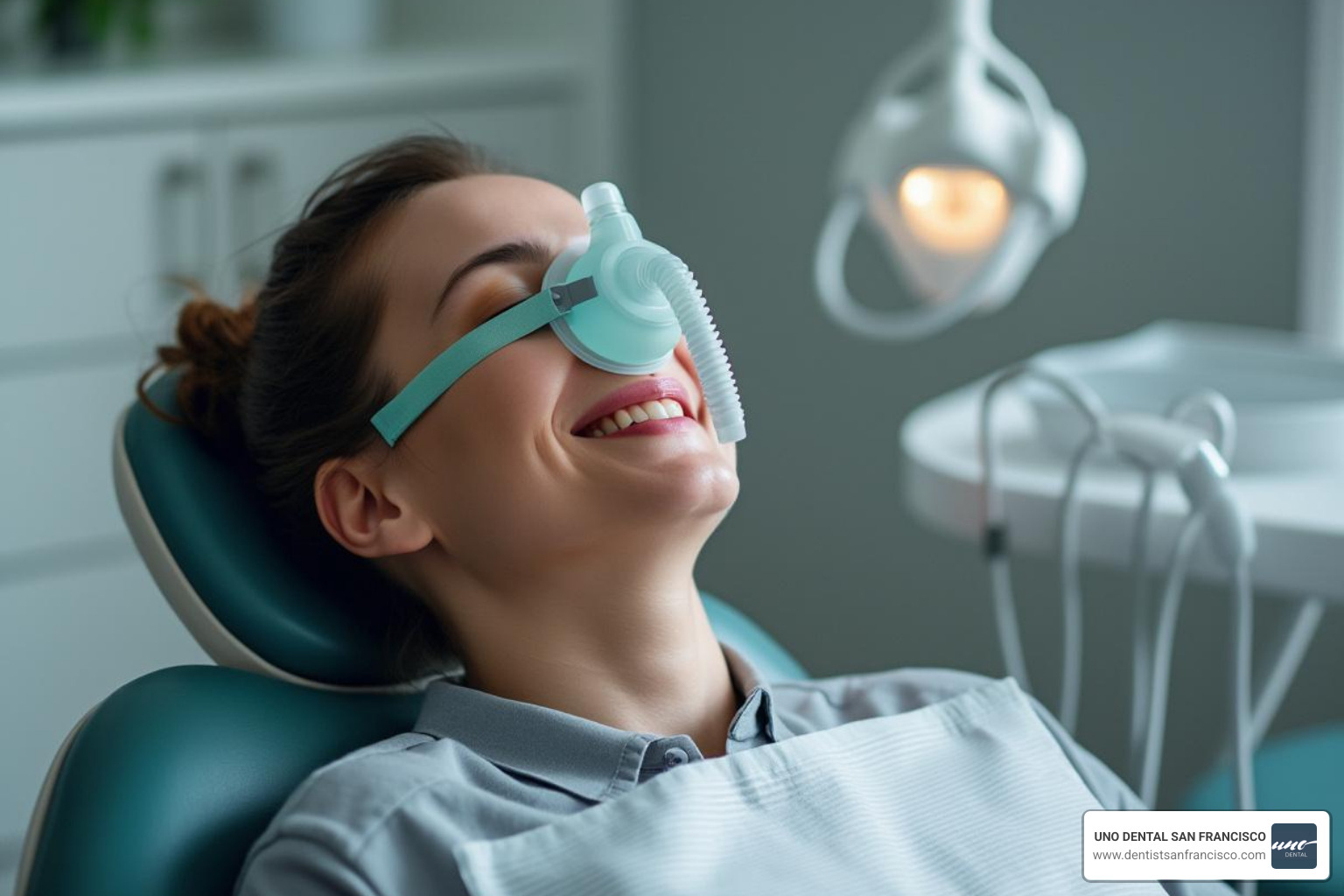
What is Dental Anesthesia and Why is it Essential for Comfortable Care?
Dental anxiety, often stemming from a fear of pain, affects 10 to 30 percent of people. Dental anesthesia is the key to overcoming this hurdle, ensuring comfortable and pain-free dental care.
Dental anesthesia uses medications to control pain and anxiety during dental procedures. It is an essential component of modern, patient-centered care, allowing us to perform comprehensive treatments while ensuring your comfort. By blocking pain signals and reducing anxiety, it makes everything from simple fillings to complex surgeries manageable and stress-free.
There are three main categories:
- Local Anesthesia: Numbs a specific area while you remain awake.
- Sedation: Induces relaxation, ranging from mild (laughing gas) to deep (IV sedation).
- General Anesthesia: Creates a temporary, controlled state of unconsciousness for extensive procedures.
This guide will cover the types of dental anesthesia, how they work, and what to expect, helping you feel more at ease during your dental visits.
I'm Dr. Mohammad Aghiad Kandar, and with over 15 years in advanced dentistry, I've seen how effective dental anesthesia transforms patient experiences. My focus on patient comfort and integrating modern techniques ensures comprehensive and compassionate care.
Glossary for dental anesthesia:
How Anesthetics Work to Prevent Pain
Anesthetics temporarily interrupt pain signals traveling from the treatment area to your brain. Local anesthetics block nerve pathways in a specific location, resulting in a reversible loss of sensation. Sedation and general anesthesia work more broadly by depressing the central nervous system to reduce awareness and induce relaxation or unconsciousness.
Most local anesthetics work within 10 minutes, with some effects lasting from 30 to 60 minutes, while others can provide numbness for over 90 minutes, ensuring ample time for treatment.
Common Dental Procedures Requiring Anesthesia
Dental anesthesia makes a wide range of procedures comfortable. The type used depends on the procedure's complexity and your anxiety level.
- Cavity Fillings: Local anesthesia numbs the tooth and gum.
- Root Canals: Local anesthesia is essential for numbing the tooth's interior during this lengthy procedure.
- Tooth Extractions: Local anesthesia is always used. Sedation may be added for complex or multiple extractions.
- Wisdom Teeth Removal: Often requires a combination of local anesthesia and sedation, or even general anesthesia.
- Dental Implants: Local anesthesia, often combined with sedation, ensures comfort during this minor oral surgery.
- Gum Disease Treatment: Local anesthesia numbs the gums for deep cleaning procedures like scaling and root planing.
- Oral Surgery: Procedures like bone grafts or cyst removal rely on appropriate dental anesthesia for a pain-free surgical environment.
A Closer Look at the Types of Dental Anesthesia
At UNO DENTAL SAN FRANCISCO, we offer a spectrum of dental anesthesia options. Understanding these choices is key to a comfortable experience. We always select the safest, most effective method for your specific needs and procedure.
Local Anesthesia: Numbing a Specific Area
Local anesthesia is the most common method for eliminating pain during dental work. It numbs a specific area, allowing you to remain fully awake but free from discomfort.
We first apply a topical numbing gel to the gum tissue to make the injection virtually painless. Then, a safe medication like Lidocaine or Articaine is administered to block pain signals from reaching the brain.
This type of dental anesthesia is ideal for procedures like cavity fillings, crowns, root canals, simple tooth extractions, and gum disease treatment. The numbness typically lasts for 1 to 3 hours, providing ample time for the procedure.
Sedation: Easing Anxiety and Discomfort
For patients with dental anxiety or those undergoing longer procedures, sedation dentistry is an excellent solution. Often called "conscious sedation" or "twilight sleep," it helps you feel completely relaxed while remaining technically awake. Many patients have little to no memory of the procedure afterward.
The American Association of Oral and Maxillofacial Surgeons offers valuable information on the different types of anesthesia. You can also find more info about our dental services, including sedation options, on our website.
We offer several types of sedation:
-
Nitrous Oxide: Known as "laughing gas," this is a great option for mild anxiety. Breathed through a small nasal mask, it induces a calm, relaxed feeling within 3-5 minutes. Its effects wear off almost instantly once the mask is removed, so you can typically drive yourself home.
-
Oral Sedation: This involves taking a prescribed pill, like Triazolam (Halcion®) or Diazepam (Valium®), about an hour before your appointment. It induces deep relaxation, and you may even doze off. For children, a liquid form like Midazolam oral syrup may be used. You will need someone to drive you to and from your appointment.
-
IV Sedation: This is the deepest form of conscious sedation offered in a dental office. Medication is administered directly into your bloodstream, allowing for precise control over your sedation level. Your vital signs are continuously monitored for safety. It is an excellent choice for patients with severe anxiety or those undergoing long procedures.
General Anesthesia: Complete Unconsciousness
For the most extensive procedures, General Anesthesia induces a state of complete unconsciousness, or a "medically induced coma." You will not feel, hear, or remember the procedure.
This is typically reserved for complex oral surgeries, such as major wisdom teeth removal or reconstructive jaw surgery, and for patients who cannot cooperate with other forms of sedation. General anesthesia is administered and monitored by an anesthesiologist or a Certified Registered Nurse Anesthetist (CRNA) in a hospital or accredited surgical center to ensure the highest level of safety.
Safety First: Risks, Side Effects, and Special Precautions
At UNO DENTAL SAN FRANCISCO, your safety is our top priority. While dental anesthesia has an excellent safety record, it's crucial to provide a full medical history—including allergies, medications, and alcohol use—so we can select the safest option for you.
Common Side Effects of Dental Anesthesia
Serious complications are rare, but some common, temporary side effects can occur depending on the type of dental anesthesia used:
- Temporary Numbness: Expected with local anesthesia, lasting a few hours. A temporary droopy eyelid or lip can also occur.
- Drowsiness/Grogginess: Common after any sedation or general anesthesia.
- Nausea/Vomiting: Can occur, especially with general anesthesia. We can provide medication to help prevent this.
- Headache: A mild headache may occur after any anesthesia.
- Soreness at Injection Site: The area of a local anesthetic injection may feel tender or bruised.
- Shivering/Feeling Cold: Can happen as general anesthesia wears off.
- Hematoma: A small, harmless bruise may form if an injection nicks a blood vessel.
- Nerve Damage: This is extremely rare but can cause prolonged numbness or altered sensation.
Here’s a summary of common side effects by anesthesia type:
| Side Effect | Local Anesthesia | Sedation (Oral/IV) | General Anesthesia |
|---|---|---|---|
| Temporary numbness/tingling | High | Low | Low |
| Droopy eyelid/lip | Low | Very Low | Very Low |
| Drowsiness/Grogginess | None | High | High |
| Nausea/Vomiting | Low | Low | Moderate |
| Headache | Low | Low | Low |
| Soreness at injection site | Moderate | Low | Low |
| Shivering/Feeling Cold | None | Low | Moderate |
| Memory loss of procedure | None | Moderate | High |
Special Precautions for Dental Anesthesia
Certain patients require special consideration to ensure the safest outcome.
-
Children: Pediatric dental anesthesia requires special care. Dosages are carefully calculated based on weight and age. We often use Midazolam syrup for liquid sedation and gentle infiltration anesthesia for baby teeth. The American Academy of Pediatric Dentistry (AAPD) provides guidelines on the safe use of local anesthesia for children.
-
Pregnancy: Please inform us if you are pregnant. While dental work is generally safe, we take extra precautions. Lidocaine and Prilocaine are considered safe anesthetics, and we typically recommend non-urgent procedures be done in the second trimester. We avoid anesthetics like Mepivacaine, Articaine, and Bupivicaine.
-
Underlying Health Conditions: Your safety is paramount if you have other health issues:
- Heart Problems: We limit adrenaline in local anesthetics.
- Liver or Kidney Disease: Dosages may be adjusted as these conditions affect how your body processes anesthesia.
- Other Conditions: Uncontrolled diabetes, bleeding disorders, or use of blood thinners require careful planning, often in consultation with your physician.
Openly discussing your health history allows us to create the safest and most effective dental anesthesia plan for you.
Preparing for Your Procedure: What to Ask and Expect
Being prepared for a procedure involving dental anesthesia is key to a calm and confident experience. At UNO DENTAL SAN FRANCISCO, we provide clear instructions to ensure your visit is as smooth as possible.
Before your appointment, we will give you pre-procedure instructions, which may include fasting guidelines (no food or drink) if you are receiving sedation or general anesthesia. For your safety, it is critical to follow these instructions.
If you receive any form of sedation or general anesthesia, you must arrange for a responsible adult to drive you home. You will also receive detailed post-procedure care instructions to guide your recovery process.
Who is Qualified to Administer Anesthesia?
The administration of dental anesthesia is strictly regulated to ensure patient safety. Qualifications vary by the type of anesthesia:
- General Dentists are licensed to administer local anesthesia. With additional training and permits, many can also provide minimal sedation (nitrous oxide) and oral sedation.
- Oral Surgeons receive extensive hospital-based training that qualifies them to administer all levels of sedation and general anesthesia.
- Dental Anesthesiologists are dentists who complete an additional 2-3 years of advanced training focused solely on anesthesia and pain management for all patient types.
- Certified Registered Nurse Anesthetists (CRNAs) are anesthesia professionals who may be part of your care team for deeper sedation or general anesthesia, focusing exclusively on monitoring your safety.
At UNO DENTAL SAN FRANCISCO, we adhere to the strict guidelines from the American Dental Association (ADA) for the use of sedation and general anesthesia by dentists, ensuring all practitioners meet rigorous safety and training standards.
Key Questions to Discuss with Your Dentist
We encourage an open discussion about your dental anesthesia plan. Consider asking the following questions:
- Which type of anesthesia is best for my procedure and why?
- What are the potential risks and side effects?
- What should I expect to feel during and after the procedure?
- What are the specific pre-operative instructions I need to follow?
- Who will administer the anesthesia, and what are their qualifications?
- How will my vital signs be monitored during the procedure?
- What does the recovery process involve, and what are my post-operative care instructions?
Frequently Asked Questions about Dental Anesthesia
At UNO DENTAL SAN FRANCISCO, we want you to be fully informed. Here are answers to some common questions about dental anesthesia.
Is dental anesthesia painful?
The purpose of dental anesthesia is to prevent pain. While many fear the injection, we first apply a topical numbing gel to the gums, which significantly reduces any sensation from the needle. Most patients report only a tiny pinch or slight pressure, followed by complete numbness during the procedure. Your comfort is our top priority.
How long does the numbness last after the dentist?
The duration of numbness depends on the type of dental anesthesia used and your individual metabolism.
-
Local Anesthesia: Numbness typically lasts 1 to 3 hours after your procedure. Longer-acting anesthetics can last longer. Be careful eating or drinking hot liquids while numb to avoid accidentally biting your cheek or tongue.
-
Sedation: The effects of nitrous oxide wear off within minutes. If you had oral or IV sedation, you will feel groggy for several hours and should rest for the remainder of the day.
-
General Anesthesia: The effects take the longest to wear off. You will feel drowsy and disoriented for several hours and will need time to recover fully.
Can I drive myself home after dental anesthesia?
Your safety is critical, and the answer depends on the type of dental anesthesia you receive.
-
After Local Anesthesia: Yes. In most cases, you can safely drive home as your alertness is not affected.
-
After Oral Sedation or IV Sedation: Absolutely not. Your coordination and judgment will be impaired. You must have a responsible adult drive you home and stay with you for a few hours.
-
After General Anesthesia: No. Driving is strictly prohibited. You must have a responsible adult drive you home and provide care as you recover.
Your Comfort is Our Priority
At UNO DENTAL SAN FRANCISCO, we believe your dental visit should be a relaxed, positive, and comfortable experience. Dental anesthesia is a vital tool that helps us achieve this, from simple local anesthesia to calming sedation options.
We carefully select the best approach for your specific needs, always prioritizing your safety and well-being. Thanks to advanced techniques and a compassionate team, you can receive the high-tech, holistic care you need without anxiety or pain.
Your journey to a healthier smile should be a pleasant one. We are here to ensure it is.
Ready to experience dentistry where your comfort comes first? We invite you to explore our patient-centered services and see how we put your well-being at the heart of everything we do.


